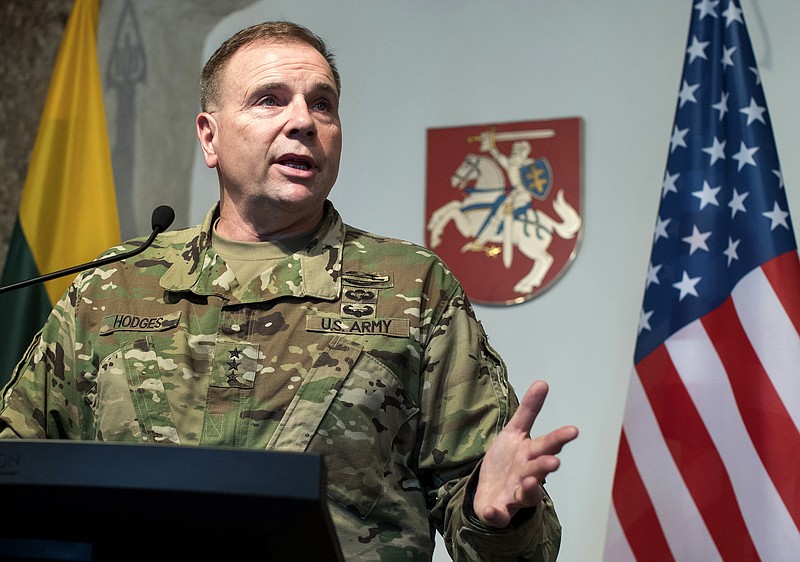BRUSSELS -- NATO Secretary-General Jens Stoltenberg on Tuesday played down concern that the United States will rush to pull thousands of its troops out of Germany, as doubts swirled in Europe about when such a withdrawal might take place.
President Donald Trump has said that he is ordering a reduction in U.S. troop strength in Germany, from around 34,500 personnel down to 25,000. Germany is a hub for U.S. operations in the Middle East and home to its European command headquarters.
"The U.S. has made it clear that no final decision has been made on how and when," Stoltenberg told reporters on the eve of two days of video meetings of NATO defense ministers, where the issue is to be discussed. Stoltenberg has spoken to Trump about the move and says he's also in contact with Germany.
"What matters for me is that we maintain credible deterrence and defense and that we maintain the strong link between North America and Europe," he said. He underlined that Washington has increased its military presence in Europe in recent years, and that European allies are spending more on defense.
Trump on Monday criticized Germany for failing to pay enough for its own defense, saying the NATO ally was "delinquent" for not meeting a goal set in 2014 for members to halt budget cuts and move toward spending at least 2% of gross national product on defense by 2024.
"Germany's delinquent. They've been delinquent for years," Trump said Monday at the White House. "They owe NATO billions of dollars and they have to pay it. Until they pay, we're removing a number of our soldiers, by about half."
In his comments Monday, Trump estimated the U.S. presence at about 52,000, a figure that may include Defense Department civilian employees.
NATO's European allies will be hoping that Defense Secretary Mark Esper can shed light on the plans over the next two days. With concern mounting about Russia's military spending and posturing, NATO is determined to show it stands ready to defend the trans-Atlantic area.
The U.S. ambassador to NATO, Kay Bailey Hutchison, said she wasn't aware of preparations for any possible troop withdrawal.
"Any kind of actual planning, I think, has not happened yet," Hutchison told reporters at a video news conference Tuesday. "I don't think that we have any kind of timeline that we have heard of."
She described Germany as "a good partner" of the United States at NATO and said that "it should not be thought that there is any walking away from Europe, and Germany."
Pulling out thousands of troops or transferring them -- speculation is rife that some of the U.S. personnel might move to Poland should this happen -- is likely to take a few months and would be costly.
Polish Foreign Minister Jacek Czaputowicz said the Polish government has been in talks with the U.S. about an increase of U.S. troops in Poland, but he said that that issue was "unrelated to recent U.S. declarations and U.S.-German relations regarding a possible reduction of the U.S. presence in Germany."
German Defense Minister Annegret Kramp-Karrenbauer declined to spar with Trump's rhetoric, saying that American soldiers are "very welcome" in the country and that Chancellor Angela Merkel's government will stand by its defense-spending commitments.
"I'll quote Voltaire, who said about friendship: 'The first law of friendship is that it has to be cultivated, and the second is that you have to be indulgent when the first law is violated'," Kramp-Karrenbauer said late Tuesday. "That's a good description of the German-American friendship at the moment."
The Social Democrats, the junior partners in Merkel's ruling coalition, also condemned the move and the way it was communicated.
Norbert Walter-Borjans, the Social Democrats' co-leader, told N-TV that the decision is another example of Trump's "America first" policy. "It's rather annoying," he said, adding that typically the U.S. president would discuss such an issue with allies before taking action.
In Berlin, Juergen Hardt, the foreign-policy spokesman for Merkel's conservative bloc in Parliament, said the move would damage trans-Atlantic relations further and weaken the NATO alliance, not to mention the American military's own global footprint.
He noted that Merkel has been pushing for more defense spending toward the 2% goal and warned that Trump's "blackmail approach" would bolster those who oppose it.
"The current push by the United States is a wake-up call to us Europeans to invest more in European defense and take more responsibly for our own security," Hardt said.
Information for this article was contributed by Lorne Cook, Vanessa Gera and David Rising of The Associated Press; and by Patrick Donahue of Bloomberg News.






